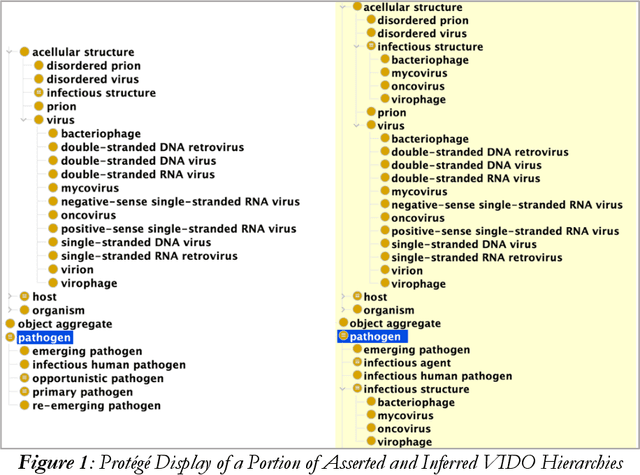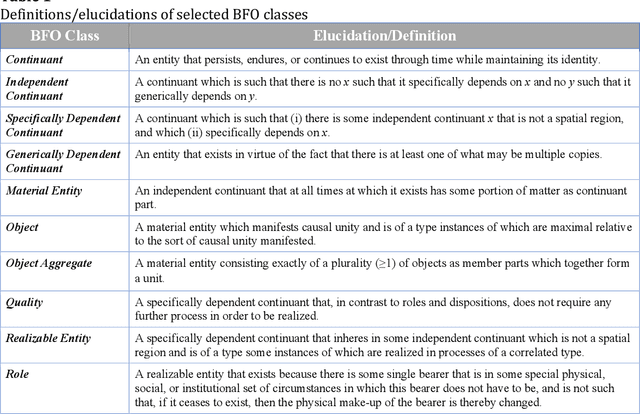John Beverley
Ontology Enabled Hybrid Modeling and Simulation
Jun 14, 2025Abstract:We explore the role of ontologies in enhancing hybrid modeling and simulation through improved semantic rigor, model reusability, and interoperability across systems, disciplines, and tools. By distinguishing between methodological and referential ontologies, we demonstrate how these complementary approaches address interoperability challenges along three axes: Human-Human, Human-Machine, and Machine-Machine. Techniques such as competency questions, ontology design patterns, and layered strategies are highlighted for promoting shared understanding and formal precision. Integrating ontologies with Semantic Web Technologies, we showcase their dual role as descriptive domain representations and prescriptive guides for simulation construction. Four application cases - sea-level rise analysis, Industry 4.0 modeling, artificial societies for policy support, and cyber threat evaluation - illustrate the practical benefits of ontology-driven hybrid simulation workflows. We conclude by discussing challenges and opportunities in ontology-based hybrid M&S, including tool integration, semantic alignment, and support for explainable AI.
How Group Lives Go Well
Apr 28, 2025Abstract:This paper explores the ontological space of group well being, proposing a framework for representing collective welfare, group functions, and long term contributions within an ontology engineering context. Traditional well being theories focus on individual states, often relying on hedonistic, desire satisfaction, or objective list models. Such approaches struggle to account for cases where individual sacrifices contribute to broader social progress, a critical challenge in modeling group flourishing. To address this, the paper refines and extends the Counterfactual Account (CT) of well being, which evaluates goodness of an event by comparing an individual's actual well being with a hypothetical counterpart in a nearby possible world. While useful, this framework is insufficient for group level ontologies, where well being depends on functional persistence, institutional roles, and historical impact rather than immediate individual outcomes. Drawing on Basic Formal Ontology (BFO), the paper introduces a model in which group flourishing is evaluated in terms of group functional, where members bear roles and exhibit persistence conditions akin to biological systems or designed artifacts. This approach enables semantic interoperability for modeling longitudinal social contributions, allowing for structured reasoning about group welfare, social institutions, and group flourishing over time.
Extending the design space of ontologization practices: Using bCLEARer as an example
Jan 30, 2025Abstract:Our aim in this paper is to outline how the design space for the ontologization process is richer than current practice would suggest. We point out that engineering processes as well as products need to be designed - and identify some components of the design. We investigate the possibility of designing a range of radically new practices, providing examples of the new practices from our work over the last three decades with an outlier methodology, bCLEARer. We also suggest that setting an evolutionary context for ontologization helps one to better understand the nature of these new practices and provides the conceptual scaffolding that shapes fertile processes. Where this evolutionary perspective positions digitalization (the evolutionary emergence of computing technologies) as the latest step in a long evolutionary trail of information transitions. This reframes ontologization as a strategic tool for leveraging the emerging opportunities offered by digitalization.
A Fourfold Pathogen Reference Ontology Suite
Dec 31, 2024



Abstract:Infectious diseases remain a critical global health challenge, and the integration of standardized ontologies plays a vital role in managing related data. The Infectious Disease Ontology (IDO) and its extensions, such as the Coronavirus Infectious Disease Ontology (CIDO), are essential for organizing and disseminating information related to infectious diseases. The COVID-19 pandemic highlighted the need for updating IDO and its virus-specific extensions. There is an additional need to update IDO extensions specific to bacteria, fungus, and parasite infectious diseases. We adopt the "hub and spoke" methodology to generate pathogen-specific extensions of IDO: Virus Infectious Disease Ontology (VIDO), Bacteria Infectious Disease Ontology (BIDO), Mycosis Infectious Disease Ontology (MIDO), and Parasite Infectious Disease Ontology (PIDO). The creation of pathogen-specific reference ontologies advances modularization and reusability of infectious disease data within the IDO ecosystem. Future work will focus on further refining these ontologies, creating new extensions, and developing application ontologies based on them, in line with ongoing efforts to standardize biological and biomedical terminologies for improved data sharing and analysis.
Mapping the Provenance Ontology to Basic Formal Ontology
Aug 02, 2024Abstract:The Provenance Ontology (PROV-O) is a World Wide Web Consortium (W3C) recommended ontology used to structure data about provenance across a wide variety of domains. Basic Formal Ontology (BFO) is a top-level ontology ISO/IEC standard used to structure a wide variety of ontologies, such as the OBO Foundry ontologies and the Common Core Ontologies (CCO). To enhance interoperability between these two ontologies, their extensions, and data organized by them, an alignment is presented according to a specific mapping criteria and methodology which prioritizes structural and semantic considerations. The ontology alignment is evaluated by checking its logical consistency with canonical examples of PROV-O instances and querying terms that do not satisfy the mapping criteria as formalized in SPARQL. A variety of semantic web technologies are used in support of FAIR (Findable, Accessible, Interoperable, Reusable) principles.
Towards a Cyber Information Ontology
Jul 26, 2024Abstract:This paper introduces a set of terms that are intended to act as an interface between cyber ontologies (like a file system ontology or a data fusion ontology) and top- and mid-level ontologies, specifically Basic Formal Ontology and the Common Core Ontologies. These terms center on what makes cyberinformation management unique: numerous acts of copying items of information, the aggregates of copies that result from those acts, and the faithful members of those aggregates that represent all other members.
Foundations for Digital Twins
May 02, 2024Abstract:The growing reliance on digital twins across various industries and domains brings with it semantic interoperability challenges. Ontologies are a well-known strategy for addressing such challenges, though given the complexity of the phenomenon, there are risks of reintroducing the interoperability challenges at the level of ontology representations. In the interest of avoiding such pitfalls, we introduce and defend characterizations of digital twins within the context of the Common Core Ontologies, an extension of the widely-used Basic Formal Ontology. We provide a set of definitions and design patterns relevant to the domain of digital twins, highlighted by illustrative use cases of digital twins and their physical counterparts. In doing so, we provide a foundation on which to build more sophisticated ontological content related and connected to digital twins.
Capabilities
Apr 30, 2024
Abstract:In our daily lives, as in science and in all other domains, we encounter huge numbers of dispositions (tendencies, potentials, powers) which are realized in processes such as sneezing, sweating, shedding dandruff, and on and on. Among this plethora of what we can think of as mere dispositions is a subset of dispositions in whose realizations we have an interest a car responding well when driven on ice, a rabbits lungs responding well when it is chased by a wolf, and so on. We call the latter capabilities and we attempt to provide a robust ontological account of what capabilities are that is of sufficient generality to serve a variety of purposes, for example by providing a useful extension to ontology-based research in areas where capabilities data are currently being collected in siloed fashion.
Grounding Realizable Entities
Apr 30, 2024



Abstract:Ontological representations of qualities, dispositions, and roles have been refined over the past decade, clarifying subtle distinctions in life science research. After articulating a widely-used characterization of these entities within the context of Basic Formal Ontology (BFO), we identify gaps in this treatment and motivate the need for supplementing the BFO characterization. By way of supplement, we propose definitions for grounding relations holding between qualities and dispositions, and dispositions and roles, illustrating our proposal by representing subtle aspects of host-pathogen interactions.
Credentials in the Occupation Ontology
Apr 30, 2024



Abstract:The term credential encompasses educational certificates, degrees, certifications, and government-issued licenses. An occupational credential is a verification of an individuals qualification or competence issued by a third party with relevant authority. Job seekers often leverage such credentials as evidence that desired qualifications are satisfied by their holders. Many U.S. education and workforce development organizations have recognized the importance of credentials for employment and the challenges of understanding the value of credentials. In this study, we identified and ontologically defined credential and credential-related terms at the textual and semantic levels based on the Occupation Ontology (OccO), a BFO-based ontology. Different credential types and their authorization logic are modeled. We additionally defined a high-level hierarchy of credential related terms and relations among many terms, which were initiated in concert with the Alabama Talent Triad (ATT) program, which aims to connect learners, earners, employers and education/training providers through credentials and skills. To our knowledge, our research provides for the first time systematic ontological modeling of the important domain of credentials and related contents, supporting enhanced credential data and knowledge integration in the future.
 Add to Chrome
Add to Chrome Add to Firefox
Add to Firefox Add to Edge
Add to Edge